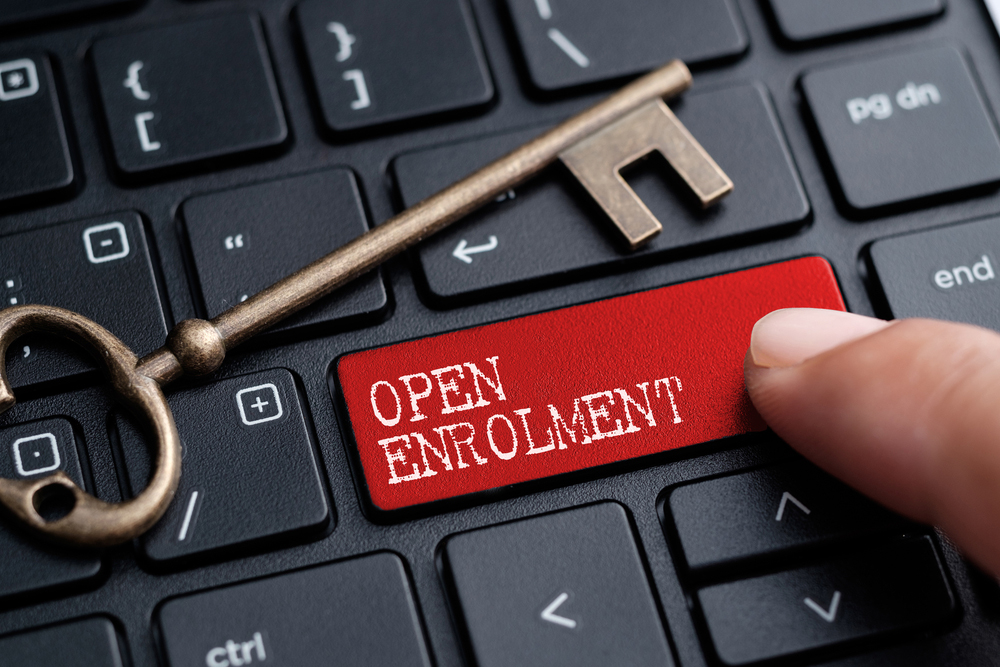The coronavirus pandemic has turned the workplace upside down. Onboarding has largely gone virtual, work has mostly gone remote, and benefits enrollment season is undergoing a radical change, too.

Social distancing guidelines and work-from-home policies have forced most benefits enrollment processes to be managed virtually. As you might expect, the switch hasn’t been hassle-free. Aside from dealing with layoffs, furloughs, hiring, and rehiring in a predominantly remote environment, HR professionals and benefits administrators have been forced to convert benefits enrollment to a virtual format.
Digital Resources on the Rise
A study by insurance company The Hartford found that because of the pandemic, 63% of employers are leaning more heavily on digital resources during this year’s open enrollment period.
Even before the pandemic, the benefits enrollment process involved a lot of heavy lifting for the people running it and a certain amount of confusion for employees trying to make benefits decisions. When you add the virtual nature of the workplace to benefits enrollment, the need becomes clear for improved enrollment workflow through the HR system that can streamline operations and empower employees.
A comprehensive HR platform should alleviate major pain points for the employer and the employee. These include:
- Assembling online and virtual enrollment tools to help employers effectively manage and control employee benefits;
- Ensuring employees feel their benefits are in order and that they can comfortably and safely review and select benefit options;
- Easing the employer’s workload when it comes to delivering benefits education and ensuring all employees participate in that education process; and
- Helping employees stay connected to the company through online communities.
Why is it so critical to have an easy-to-navigate enrollment process? For one thing, it can help employees dedicate more time to choosing their benefits. A Colonial Life & Accident Insurance Co. study of 1,200 U.S. consumers found that 73% spend less than an hour and 41% spend less than 30 minutes reviewing their benefits at enrollment time. Moreover, nearly 90% of consumers confessed they lack understanding of their benefits.
Given those startling statistics, employers in the pandemic era must strive even harder to communicate with employees about their benefits and ensure all their benefits questions are answered. A strong HR platform with benefits enrollment workflows can help employers achieve this.
A Strong Platform Can Help Ease the Burden
“We’ve seen employers begin to transition to more digital tools over time, but for many, the shift to a more virtual experience has been accelerated due to the pandemic,” says Jonathan Bennett, head of group benefits at The Hartford.
In tandem with the vacuum of understanding about benefits, employees are valuing certain benefits even more because of the pandemic. These include:
- Employee assistance programs
- Hospital indemnity insurance
- Critical illness insurance
- Behavioral and mental health services
- Wellness benefits
- Pet insurance
The right technology can make it easier for employees to sort through their menu of benefits. Meanwhile, employers must stay on top of employees’ wants and needs regarding benefits in order to attract and retain talent, particularly because there’s heightened interest in certain benefits this year, a priority being comprehensive health insurance during the pandemic.
A workflow management system can assist in this regard by enabling better organization of open enrollment and by further opening the lines of communication with employees.
“A silver lining in the pandemic environment is the realization [that] high-tech tools aren’t separate capabilities to people,” according to Insurance News Net, “but rather something that can be packaged for a more cohesive, personalized enrollment strategy….”
Silver Linings
A couple of other silver linings for virtual enrollment? Employees can go over benefits materials online with their family members, and they can ask questions confidentially rather than in a conference room.
So, while the pandemic might feel like a dark cloud hanging over the American workplace, technology in the form of a workflow management system and other human capital management (HCM) tools can at least bring some light—and efficiency—to the benefits enrollment process.

Trish Stromberg is the chief marketing officer at iSolved HCM, leading the marketing and iSolved University teams with innovative brand positioning and exemplary customer experiences. For the past 20 years, Stromberg has refined her expertise across myriad aspects of marketing—demand generation, product launches, branding initiatives, and event management.
During her career, she has taken the helm at notable organizations to develop overall missions, product positioning, and go-to-market strategies. Stromberg received her marketing communications degree, Summa Cum Laude, from Weber State University.
